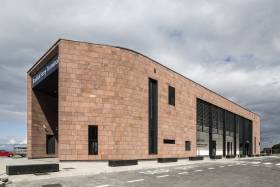Displaying items by tag: Brodick, Arran
Brand New Ferry Terminal Opens On Arran, Firth of Clyde
#FerryNews - The first passengers to use Scottish operator CalMac’s brand new ferry terminal on Isle of Arran, Firth of Clyde, became a reality on Tuesday with sailings operating to and from Ardrossan, writes Jehan Ashmore.
Ferry, Caledonian Isles made the inaugural berthing at the new terminal in Brodick, the island’s main town on the east coast. The terminal in Brodrick Bay is also a popular scenic anchorage for leisure craft that has included the schooner superyacht Eos.
The new facility, Afloat adds also incorporates a pier berth-linkspan to cater also for a new dual-fuel ferry powered by liquefied natural gas (LPG) and marine-gas oil (MGO).
The newbuild currently under construction, Glen Sannox (first of a pair) assigned to Arran route, was expected to enter service last summer on the busy short-sea route that takes just under an hour. Due to complex engineering works at the Fergusan Marine Engineering Ltd (FMEL), Port Glasgow, the new 102m ferry has been rescheduled with a debut expected in the second half of 2018.
The ferry terminal project as previously reported in 2016 (see photo) is Arran’s main ferryport and was completed by Caledonian Maritime Assets Limited (CMAL). The terminal which is an extensive upgrade of the facilities is to be officially opened with details to be released within weeks.
The other island terminal is at Lochranza from where the shorter ferry routes linking Claonaig and Tarbart albeit in the more remote Kintyre Peninsula as distinct to Ardrossan in Ayrshire.
CMAL adds the completion of the £30 million redevelopment project was unexpectedly delayed by an issue relating to the automated door closure on the passenger access system (PAS). The project was substantially complete in summer last year, but the PAS failed to receive its CE mark certification and could not be used. The issue has now been resolved and CE mark certification is in place.
The redevelopment project has completely transformed the terminal, delivering a new pier, an increased marshalling area through reclaimed land and a modern terminal building, with bus stances and parking facilities. It was CMAL’s single biggest port infrastructure construction project delivered.
In addition to CMAL’s role, the project was given support from Transport Scotland, North Ayrshire Council, Strathclyde Partnership for Transport and Coastal Communities Fund.
























































